Tool Cabinets Are Overrated
Many woodworks feel building a beautiful wall cabinet to house and display their tools is a rite of passage and a shop necessity. Mike Farrington says this is folly.
It’s funny how certain things become controversial. Even within the docile woodworking community, the fiery debate about pins first. vs. tails first rages on. If you don’t know what I am talking about, some woodworkers believe the pins portion of a dovetail should be cut first while others think it should be the tails. I have cut dovetails both ways and I really don’t think one way is better. To each their own, as they say.
There is, however, a topic that I have a strong opinion about. I wonder whether you will disagree. I have a problem with the idea of a wall-hanging tool cabinet. Many woodworkers believe building a beautiful wall cabinet to house and display their tools is a rite of passage and a shop necessity. To me, this is folly. How is it convenient to store tools up on the wall away from one’s workbench? Unless the tool cabinet is hung right above the workbench, where it could be in the way of larger projects, in my opinion it’s too far away.
To me, there is one simple solution. Commonly used bench tools should be stored in a cabinet under a bench, shoehorned into the bench’s frame. It doesn’t matter if you are using an old solid-core door, a slice of a bowling lane, or the most beautiful heirloom Roubo bench, tools should be stored beneath the benchtop. I realize that many features people like to incorporate into their bench may interfere with the doors or drawers of said cabinet., but I suggest if you are smart enough to install a leg vise or a sliding deadman, you have the ability to incorporate some storage under there as well. A perfect example of what I’m talking about is the Ultimate Shaker Workbench that Mike Pekovich and Matt Kenney built for the Fine Woodworking shop. Check it out; there is a video series documenting the build right here on this very site.
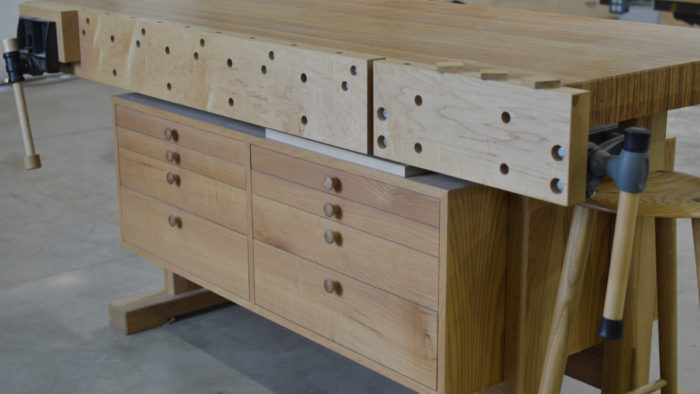
My traditional cabinetmaker’s bench has eight graduated drawers beneath its apron, which is home to tail and end vises. In these drawers I store my chisels, marking tools, sharpening supplies, handplanes, files/rasps, smaller handsaws, dovetail tools, spokeshaves, and the list goes on. I see a few advantages to keeping tools in this location. First, they are easily accessed via 100-lb. full-extension drawer slides. I can exchange handplanes, chisels, or marking tools without taking a step away from my bench. I find this to be extremely efficient. (If you are one who is trying to increase your step count for the day, this could be a disadvantage.) Second, if you move your bench around in your shop, the tools will move with it. Last, when planing hardwoods, sawing rigorously, or chopping joinery, you want a bench with all the weight it can get. Much like a tractor, weight equals traction (unless it’s really muddy, which I hope it’s not in your shop…).
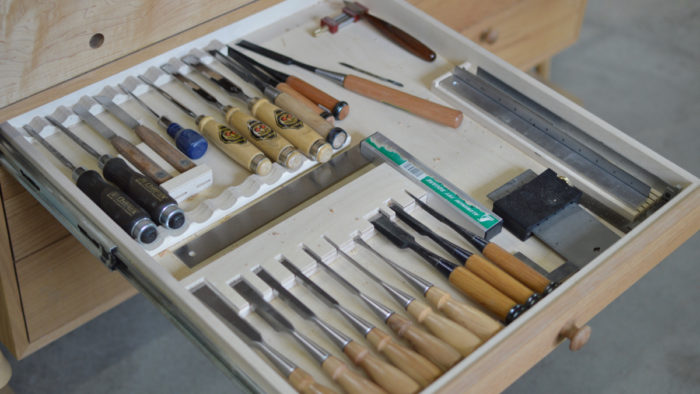
To argue the flip side to my position, many woodworkers I look up to and consider heroes have wall-hanging tool cabinets. Garrett Hack, Chris Gochnour, Mike Pekovich, and many others come to mind. They all produce incredible work and when I watch their videos they flow pretty well in the shop. Mike also has a video series about building a wall-hanging tool cabinet for his home shop where he mentions when he opens his tool cabinet it transforms his garage into a proper wood shop, I get that. Also, perhaps something large is stored below your bench like a router table. That makes sense, too.
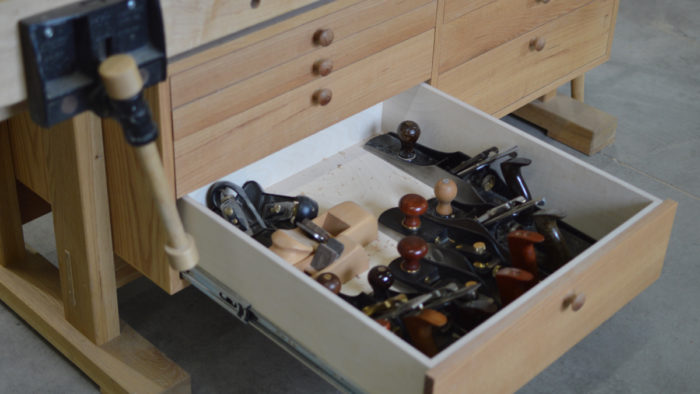
The point of this article is to get you thinking about the most important tool in any wood shop, the place where the most efficiencies can be gained or lost, the place where every project begins and ends—the workbench. I have made my case as to why tools should be stored beneath your bench. What say you?
I am in the planning stages of adding a twin screw vise to my bench. When completed, I will post a build video on my glorious YouTube channel where I will show the vise install and go into more detail about workbench storage. Thank you very much for reading. Until next time…
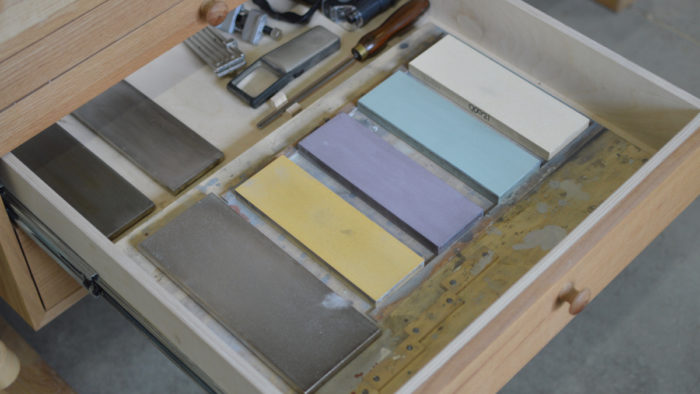
 |
Introduction: Ultimate Shaker WorkbenchVideo Workshop by Mike Pekovich and Matt Kenney |
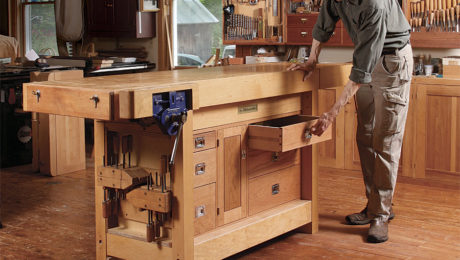 |
Under-Bench Tool Cabinetby Christian Becksvoort |
 |
Divide and Conquerby Mike Pekovich |
Fine Woodworking Recommended Products

Woodriver Rechargeable Desiccant Bag

WoodRiver Router Bit Storage Case























Comments
Mike, I agree with you. I take it a step further and don't even bother with drawers. The tools under the bench can get dust and shavings on them, but daily vacuuming and sweep up takes care of that. The problem with drawers is I often have clamped-up work overhanging the front of the bench, which would prevent access to some of the drawers.
I also use a movable tool rack on the edge of the bench that holds most of my most used tools within easy reach. Most workers mount these tools on the wall, but I think a bench should be freestanding to accommodate larger dimension work.
The tool rack shown is easily constructed of plywood.
http://johnbarfielddesign.com/
I have two torsion box workbench tops, that are designed to sit on a workmate. The main advantage this gives me is versatility. I can easily drop the height by folding up the legs, very useful if I'm building something tall, or if the kids want to build something.
One of the benches is a variation on the new fangled workbench and can have the planing beam attached (full bench top to floor range of movement), the other is a simple box with a vise at one end.
Under bench storage is detrimental to the versatility of this set up, so all my tools (power and hand) are stored on the walls.
Seems to me that whatever way you go, it is the making of that solution that is the rite of passage. Especially when you move away from how other people have done things and truly get to how you want to do things (rollaway 2 car garage, full New Yankee with all the big toys, cupboard under the stairs and anywhere in between).
I would love to have drawers beneath my bench, but I have a small shop. That seems to be at odds with the whole space-efficiency theory but I have one of those mini benches designed by another woodworking hero, Steve Latta, and it resides under my main bench. I could make small drawers up high or one layer of drawers underneath it... Maybe I could set up some pulleys and ropes and hand the mini bench above my work area (OSHA doesn't visit my shop).
Organizing a shop is a constant evolution. I have tools on the wall, tools in drawers in other cabinets I've built on roll-arounds, and there's always a demand for more!
You should put tiny drawers in the bottom of your mini-bench!
That's a great idea.
As an amateur woodworker, speed and efficiency isn't a big priority. So I really wouldn't mind if I were exclusively working out of a tool cabient on the wall or a tool chest.
I do store things underneath and the less frequently used items in the cabinets. The current layout works well.
The thing I would like to change the most is moving the bench to a center of a room. If I were to do it over again, I'd probably have a cabinet to side of my workbench and a well for storing tools on the workbench itself. The pegboard I am currently using keeps things handy and close. I don't like the bench in the corner of the garage as some work on the right hand side of the bench feels a bit cramped. Given it's a garage and I park the car in at nights, it's an ok compromise.
I appreciate this point of view but I prefer a wall hanging cabinet with the hand tools at eye-level and not having to bend over so much. With that said, I feel storage should always be built below the bench top. If you just have one big void there it becomes an inefficient catch-all.
I like Mike's point, but I don't want to bend over any more than I have to. So the hand tools will go in a wall cabinet and my power tools will reside under the bench when it's not collapsed.
I’m with you Mike but unlike pins v tails this debate will naturally boil down to shop layout and bench design. It’s hard to throw shade on someone who hangs tools on the wall if their bench is portable. As for those with the choice and who choose to hang tools on the wall, well, those are probably the same wingnuts who cut tails first.
"Folly"? I would say that it is true folly to characterize a wall cabinet as "folly". But then you go on to qualify your folly with "Unless the tool cabinet is hung right above the workbench". Where else would one logicly hang ones tool cabinet? Personally I would prefer to reach out/up than down.
There is yet another solution - I manage with a set of nails in a batten under 6" shelf on the wall behind the bench, the shelf has the glues, and polishes tapes, etc I regularly need on it, and the nails are for rulers, marking knives, sliding squares.. all of which hang flat; then under the bench is a series of tool boxes holding drill, screws, nails... which adds weight to the bench (it never moves) The rest of the tools are in a series of drawers behind me when I am at the bench - seems to work for me.
6 of 1 half dozen of the other. Do what makes you feel good.
It makes my back hurt to think about squatting down or bending over every time I need a new chisel, plane or other hand tool for the bench. In my shop, a quick twist to the nearby wall is far more convenient than bending down (ouch) and pulling out a heavy drawer full of planes (ouch again) then closing the drawer and standing up again (ouch some more). There is a reason why woodworkers make wall cabinets or their equivalent, whether pegboard or otherwise.
GaryK60 hit the nail on the head. It is really a personal choice and one that reflects the way that you work. Its like most things in woodworking, there are always options/alternatives based on the requirements of the user.
Surely this is folly. Far better is to just keep your tools right there on the bench :)
Actually, I do agree with Mike that a tool cabinet would be quite impractical for me. I do keep my chisels on an extension of my bench since I use them so much. The rest of the stuff I use a lot is on another work surface and on racks right behind me within a few feet of reach. Super efficient for my work flow.
--Wm. F. Brown
http://www.MaineCoastWorkshop.com
I've built a wall hanging tool cabinet. It was lovely. It was also a pain in the neck! Then I went to a floor mounted, drawered tool case. It was better but still a bit of a nuisance. I'm giving serious consideration to a couple of rolling tool caddies. One will go in the space beneath my Powermatic 2000/router table combo for blades, bits, appropriate wrenches, etc. I'll probably build another for 'everything else' and store it to one side except when I need it. I expect to also keep a lot of hand power tools on the shelf beneath the new McBrian bench I'm about to start. However, as has been stated above, this is me. YMMV.
Sorry, but this seems like an attempt to stir up controversy where there is none. Excuse my expounding here...but I am just about 1/2 way through a tool box built and I went through quite a bit of thinking, reading and ultimately drafting before getting down to it. First off Ive never seen it in any book or article advocated as "A Rite of Passage"? I was the president of the Central Jersey Woodworking Association for five years and heard a lot of strong opinions about...well, just about everything! And I've never heard anyone express this concept.
True enough that FWW and Taunton have published more that a few articles about such a cabinet, and the ever popular contributor Christian Becksvoort is often photographed with his great box in the background. And of course there is the Studley Toolbox (how apt is that name? That thing is STUD-LY!) Its also worth pointing out that Studley built his tools and the box at the apex of his career not at the end of an apprenticeship or journeyman period.
Taunton also published several articles and a whole book "The Toolbox Book" (Tolpin, 1998), which is a great study of all the myriad ways woodworkers manage the challenge of simultaneously keeping tools protected and yet accessible. I know that NBS has all of its furniture student design and build a tool chest as a first year assignment. And yet, Chris Schwarz and Megan Fitzpatrick are big proponents of the trunk style, top loading chest.
Building your own bench? I think the case for that being a rite of passage can be made. What seems to me to be the larger important "stage gate" one must pass through to be a "woodworker" is to set up your shop. A space where the tools and the skills to use them are uninhibited (or as much as possible) by the space they occupy.
Log in or create an account to post a comment.
Sign up Log in